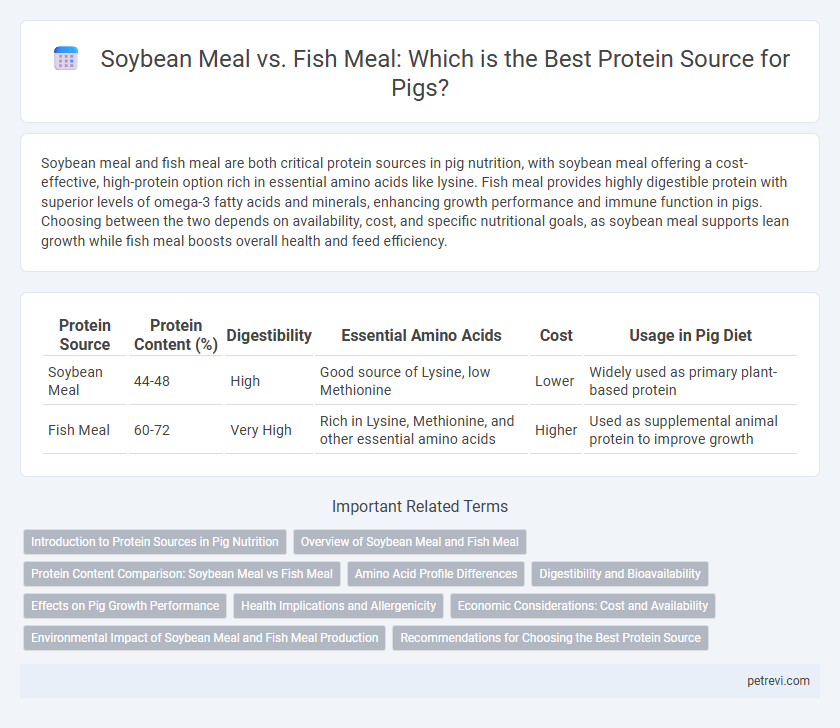Soybean meal and fish meal are both critical protein sources in pig nutrition, with soybean meal offering a cost-effective, high-protein option rich in essential amino acids like lysine. Fish meal provides highly digestible protein with superior levels of omega-3 fatty acids and minerals, enhancing growth performance and immune function in pigs. Choosing between the two depends on availability, cost, and specific nutritional goals, as soybean meal supports lean growth while fish meal boosts overall health and feed efficiency.
Table of Comparison
| Protein Source | Protein Content (%) | Digestibility | Essential Amino Acids | Cost | Usage in Pig Diet |
|---|---|---|---|---|---|
| Soybean Meal | 44-48 | High | Good source of Lysine, low Methionine | Lower | Widely used as primary plant-based protein |
| Fish Meal | 60-72 | Very High | Rich in Lysine, Methionine, and other essential amino acids | Higher | Used as supplemental animal protein to improve growth |
Introduction to Protein Sources in Pig Nutrition
Soybean meal and fish meal are primary protein sources in pig nutrition, each offering distinct amino acid profiles essential for optimal growth. Soybean meal provides a high level of digestible protein with abundant lysine, making it a cost-effective choice in swine diets. Fish meal, rich in essential amino acids such as methionine and lysine, enhances protein quality and supports immune function but typically comes at a higher cost.
Overview of Soybean Meal and Fish Meal
Soybean meal is a widely used plant-based protein source for pigs, rich in essential amino acids like lysine and highly digestible protein. Fish meal, derived from processed fish, offers a high-quality protein profile with abundant omega-3 fatty acids and essential amino acids, supporting pig growth and immune health. Both protein sources supply critical nutrients, but soybean meal is favored for cost-effectiveness and availability, while fish meal is valued for its superior amino acid balance and palatability.
Protein Content Comparison: Soybean Meal vs Fish Meal
Soybean meal typically contains 44-48% crude protein, making it a primary plant-based protein source in pig diets, while fish meal offers a higher protein content, often ranging from 60-72%, providing more concentrated amino acids. The higher protein content in fish meal supports enhanced growth performance and feed efficiency in pigs, especially during early growth stages. However, soybean meal remains a cost-effective and widely available alternative with essential amino acid profiles suitable for balanced swine nutrition.
Amino Acid Profile Differences
Soybean meal offers a balanced amino acid profile rich in lysine, which is essential for pig growth and muscle development, whereas fish meal provides a higher concentration of methionine and cysteine, sulfur-containing amino acids crucial for overall metabolism and immune function. Fish meal typically contains more digestible protein and essential amino acids but may have variability depending on source and processing methods. Optimal pig diets often combine both protein sources to leverage soybean meal's lysine content and fish meal's sulfur amino acids for enhanced amino acid balance and pig performance.
Digestibility and Bioavailability
Soybean meal exhibits high digestibility with approximately 85-90% crude protein digestibility in pigs, making it a cost-effective protein source. Fish meal provides superior bioavailability of essential amino acids such as lysine and methionine, enhancing protein synthesis and growth performance in swine. The choice between soybean meal and fish meal depends on balancing digestibility rates with the bioavailability of specific amino acids critical for pig development.
Effects on Pig Growth Performance
Soybean meal and fish meal are widely used protein sources in pig diets, each influencing growth performance differently. Soybean meal provides a rich source of essential amino acids, promoting steady weight gain and efficient feed conversion rates, while fish meal contains highly digestible proteins and omega-3 fatty acids that enhance growth rates and immune function. Studies indicate pigs fed fish meal diets often exhibit improved average daily gain and better lean tissue deposition compared to those consuming soybean meal alone.
Health Implications and Allergenicity
Soybean meal is a widely used protein source in pig diets due to its high protein content and favorable amino acid profile, but it contains antinutritional factors like trypsin inhibitors that can affect gut health and nutrient absorption. Fish meal offers highly digestible protein and essential omega-3 fatty acids, promoting improved growth and immune function in pigs, though it may pose allergenic risks related to fish proteins, which can trigger sensitivities in certain animals. Balancing soybean meal and fish meal can optimize pig health by providing essential nutrients while minimizing allergen exposure and digestive disturbances.
Economic Considerations: Cost and Availability
Soybean meal is generally more cost-effective than fish meal due to its widespread availability and stable market prices, making it a preferred protein source in pig diets. Fish meal, while higher in protein quality and digestibility, tends to be more expensive and subject to supply fluctuations, limiting its economic feasibility for large-scale pig production. Producers often balance cost and nutritional benefits by incorporating soybean meal as the primary protein source supplemented with fish meal when budget allows.
Environmental Impact of Soybean Meal and Fish Meal Production
Soybean meal production for pig protein sources involves significant land use and deforestation, contributing to biodiversity loss and increased carbon emissions. Fish meal production relies heavily on wild fish stocks, leading to overfishing and marine ecosystem disruption, impacting ocean sustainability. Comparing environmental impacts, soybean meal has a higher land-use footprint, while fish meal poses greater risks to aquatic biodiversity and fish populations.
Recommendations for Choosing the Best Protein Source
Soybean meal is favored for pig diets due to its high digestible protein content and balanced amino acid profile, particularly rich in lysine essential for growth. Fish meal offers superior bioavailability of amino acids and omega-3 fatty acids, supporting immune function and development but may increase feed costs and risk of off-flavors in pork. Choosing between soybean and fish meal should consider cost-effectiveness, nutritional requirements, and potential impacts on meat quality to optimize pig performance and profitability.
Soybean meal vs Fish meal for Pig protein source Infographic

 petrevi.com
petrevi.com